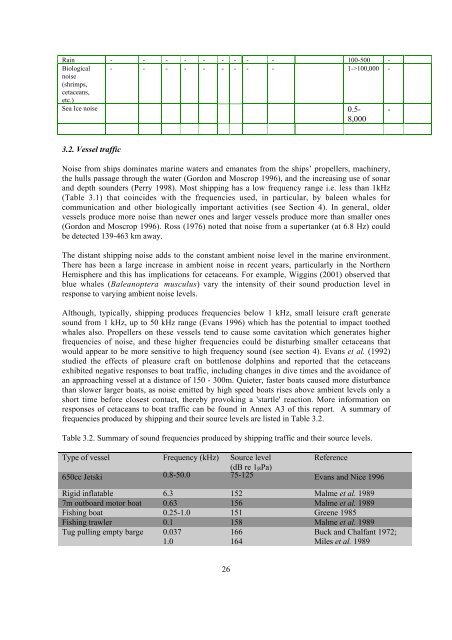Oceans of noise - Whale and Dolphin Conservation Society
Oceans of noise - Whale and Dolphin Conservation Society
Oceans of noise - Whale and Dolphin Conservation Society
Create successful ePaper yourself
Turn your PDF publications into a flip-book with our unique Google optimized e-Paper software.
Rain - - - - - - - - - 100-500 -<br />
Biological<br />
<strong>noise</strong><br />
(shrimps,<br />
cetaceans,<br />
etc.)<br />
- - - - - - - - - 1->100,000 -<br />
Sea Ice <strong>noise</strong> 0.5-<br />
8,000<br />
-<br />
3.2. Vessel traffic<br />
Noise from ships dominates marine waters <strong>and</strong> emanates from the ships’ propellers, machinery,<br />
the hulls passage through the water (Gordon <strong>and</strong> Moscrop 1996), <strong>and</strong> the increasing use <strong>of</strong> sonar<br />
<strong>and</strong> depth sounders (Perry 1998). Most shipping has a low frequency range i.e. less than 1kHz<br />
(Table 3.1) that coincides with the frequencies used, in particular, by baleen whales for<br />
communication <strong>and</strong> other biologically important activities (see Section 4). In general, older<br />
vessels produce more <strong>noise</strong> than newer ones <strong>and</strong> larger vessels produce more than smaller ones<br />
(Gordon <strong>and</strong> Moscrop 1996). Ross (1976) noted that <strong>noise</strong> from a supertanker (at 6.8 Hz) could<br />
be detected 139-463 km away.<br />
The distant shipping <strong>noise</strong> adds to the constant ambient <strong>noise</strong> level in the marine environment.<br />
There has been a large increase in ambient <strong>noise</strong> in recent years, particularly in the Northern<br />
Hemisphere <strong>and</strong> this has implications for cetaceans. For example, Wiggins (2001) observed that<br />
blue whales (Baleanoptera musculus) vary the intensity <strong>of</strong> their sound production level in<br />
response to varying ambient <strong>noise</strong> levels.<br />
Although, typically, shipping produces frequencies below 1 kHz, small leisure craft generate<br />
sound from 1 kHz, up to 50 kHz range (Evans 1996) which has the potential to impact toothed<br />
whales also. Propellers on these vessels tend to cause some cavitation which generates higher<br />
frequencies <strong>of</strong> <strong>noise</strong>, <strong>and</strong> these higher frequencies could be disturbing smaller cetaceans that<br />
would appear to be more sensitive to high frequency sound (see section 4). Evans et al. (1992)<br />
studied the effects <strong>of</strong> pleasure craft on bottlenose dolphins <strong>and</strong> reported that the cetaceans<br />
exhibited negative responses to boat traffic, including changes in dive times <strong>and</strong> the avoidance <strong>of</strong><br />
an approaching vessel at a distance <strong>of</strong> 150 - 300m. Quieter, faster boats caused more disturbance<br />
than slower larger boats, as <strong>noise</strong> emitted by high speed boats rises above ambient levels only a<br />
short time before closest contact, thereby provoking a 'startle' reaction. More information on<br />
responses <strong>of</strong> cetaceans to boat traffic can be found in Annex A3 <strong>of</strong> this report. A summary <strong>of</strong><br />
frequencies produced by shipping <strong>and</strong> their source levels are listed in Table 3.2.<br />
Table 3.2. Summary <strong>of</strong> sound frequencies produced by shipping traffic <strong>and</strong> their source levels.<br />
Type <strong>of</strong> vessel Frequency (kHz) Source level<br />
Reference<br />
(dB re 1µPa)<br />
650cc Jetski 0.8-50.0 75-125 Evans <strong>and</strong> Nice 1996<br />
Rigid inflatable 6.3 152 Malme et al. 1989<br />
7m outboard motor boat 0.63 156 Malme et al. 1989<br />
Fishing boat 0.25-1.0 151 Greene 1985<br />
Fishing trawler 0.1 158 Malme et al. 1989<br />
Tug pulling empty barge 0.037<br />
1.0<br />
26<br />
166<br />
164<br />
Buck <strong>and</strong> Chalfant 1972;<br />
Miles et al. 1989

















